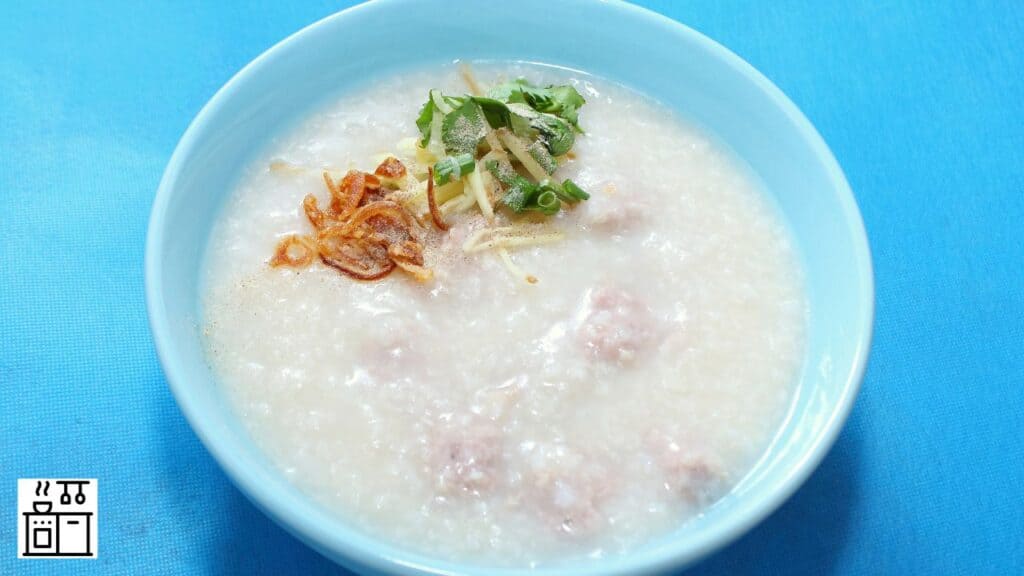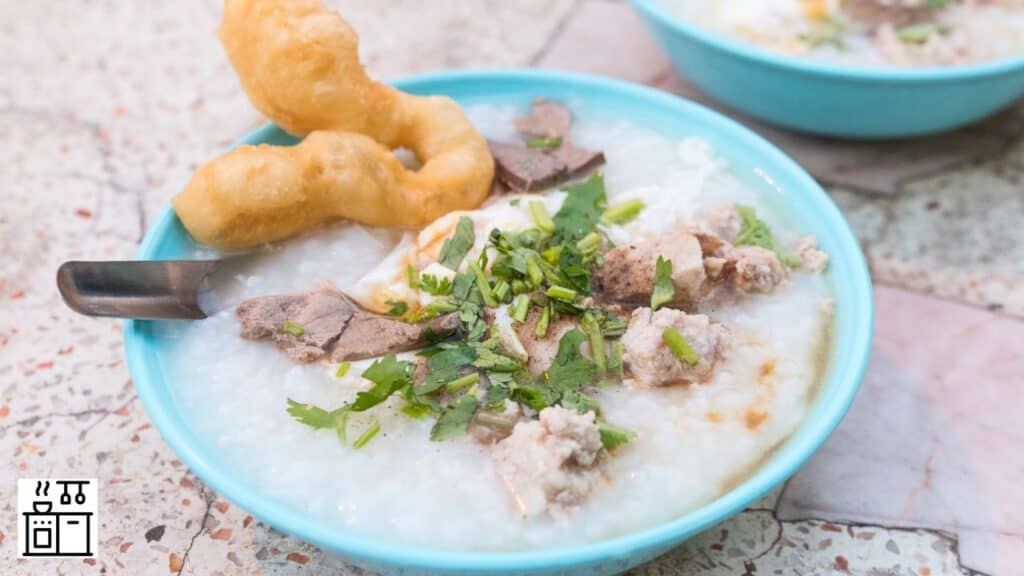Some rice cooker models have a congee or porridge setting. In this case, you can easily use this function to make a congee.
But you can make congee in a rice cooker even if this function is not available.
Let’s take a look at both options in closer detail.
Steps to Make Congee in A Rice Cooker with The Congee or Porridge Option
The following sequence of steps works if your rice cooker has a “Congee” or “Porridge” option.
In this case, you can add the ingredients to the cooking pot and enable the Congee or Porridge setting. The rice cooker takes care of the rest.
Here are the steps.
1. Measure the Rice and Wash It
You can make congee using any variety of rice. But the commonly used variety is jasmine rice.
Measure the adequate quantity of rice for congee using the measuring cup that comes with the rice cooker.
After measuring the rice, wash it thoroughly.
Place the rice in a mesh vessel or colander and rinse it with water till the water runs clear.
You can squish and swirl the rice to get rid of any dirt.
This process will also eliminate the excess starch and prevent the rice grains from becoming sticky.
2. Fill the Rice Cooker with An Adequate Quantity of Water
If your rice cooker has a congee setting, it will also have a water level indicator on the cooking pot.
The water level indication will be different for rice and other ingredients.
You will need more water for congee than is needed for rice. Hence, it’s important to choose the right level indication.
Add rice to the pot. Then, fill it with water till the corresponding level in the indicator column for porridge.
So, if you are using 1 cup of rice, fill the pot with water till the porridge water indicator mark 1.
3. Add Seasonings and Other Ingredients
For plain congee, season the water with salt and stir it before switching on the rice cooker.
If you would like to add other ingredients like vegetables or pieces of meat, there are two options.
Add ingredients that take longer to cook at the very beginning.
However, if they will cook quickly, add them mid-way through the cooking process.
If you want your congee to be more flavorful, replace water with broth or stock.
Some people like to add glutinous rice flour to the congee for thickness and texture.
There are numerous ways to customize it, and you can choose the setting that works best for you.
4. Enable the “Congee” or “Porridge” Setting
Once you add all the ingredients to the cooking vessel, close the lid of the rice cooker.
Then, plug in the rice cooker and enable the Congee setting.
The appliance will now start cooking. The cooking time will depend on the rice cooker model and the amount of rice.
The cooker will automatically adjust to the appropriate setting. So you don’t have to supervise it.
5. Wait for The Cooker to Shut Down or Switch to “Keep Warm”
When the congee is ready, the rice cooker will automatically shut down or switch to the “Keep Warm” mode.
The congee is ready to serve at this stage.
You can open the lid and stir the congee once. Then, transfer it to a bowl and enjoy it warm.
If you don’t wish to consume it immediately, let the congee continue on the “Keep Warm” mode of the rice cooker for safe storage.
In this mode, the rice cooker stores the contents at an elevated temperature so that it doesn’t spoil.
However, if you store the congee at room temperature, it will spoil much faster.
Steps to Make Congee in A Rice Cooker without The Congee Option

Rice cookers with the congee option make cooking easier to prepare congee. But you can make congee in a rice cooker even if this setting is absent.
The only difference is that you will have to manually stop the cooking process without waiting for the rice cooker to switch off automatically.
Here are the steps to make congee with the “Congee” option.
1. Prepare the Rice for Cooking
The first step is to clean and rinse the rice. Measure the adequate quantity of rice and wash it thoroughly.
Change the water four to five times to ensure that the grains are cleaned properly.
It will also help to get rid of the excess starch that makes the rice sticky.
2. Prepare the Rest of The Ingredients, Including Water
The ratio of rice to water is different for congee. You should measure this accurately if your rice cooker doesn’t have a porridge level indicator.
To make congee in the rice cooker, the rice-to-water ratio is typically 1:8. So for each cup of rice, you should add 8 cups of water.
Depending on the rice cooker model and type of rice used, you may have to adjust the amount of water. But this is a good starting point.
When adding water to the rice cooker, don’t exceed more than two-thirds of the cooking pot. Exceeding this level can make the water overflow.
3. Add the Rest of The Ingredients
If you like flavored congee with more ingredients besides rice, use spices, herbs, vegetables, or meat in the recipe.
You can also use broth or stock instead of water to make the congee more flavorful.
For simple congee, season the water with salt at this stage. This will allow it to mix, and the entire congee will be evenly seasoned.
3. Switch on The Rice Cooker
After adding the ingredients, close the lid and switch on the rice cooker. Use the regular rice cooking setting to cook the congee.
Since this method doesn’t depend on the porridge setting, you must manually check on the congee at regular intervals.
You can also cook it uncovered if required. Stir occasionally for the first 45 minutes until the congee is smooth and the rice grains cook.
If there are other ingredients, add them at the right time so they get enough time to cook.
Harder cuts like meat or seafood will usually take longer than vegetables to cook.
To check for doneness, take a spoon of the congee and squish the grains. The rice should be fully cooked.
4. Switch Off the Rice Cooker or Change It to “Keep Warm”
The rice cooker will not automatically shut down or switch to Keep Warm when moisture remains since it doesn’t have a porridge setting.
You should manually stop the cooking process.
Either switch off the power to the cooker or manually toggle the “Keep Warm” setting to stop the cooking process.
In the “Keep Warm” mode, the congee will remain at an elevated temperature.
It will prevent microbial growth and ensure that the congee is safe for consumption even after a few hours of cooking.
If the rice cooker doesn’t have this function, ensure that you consume the congee quickly.

